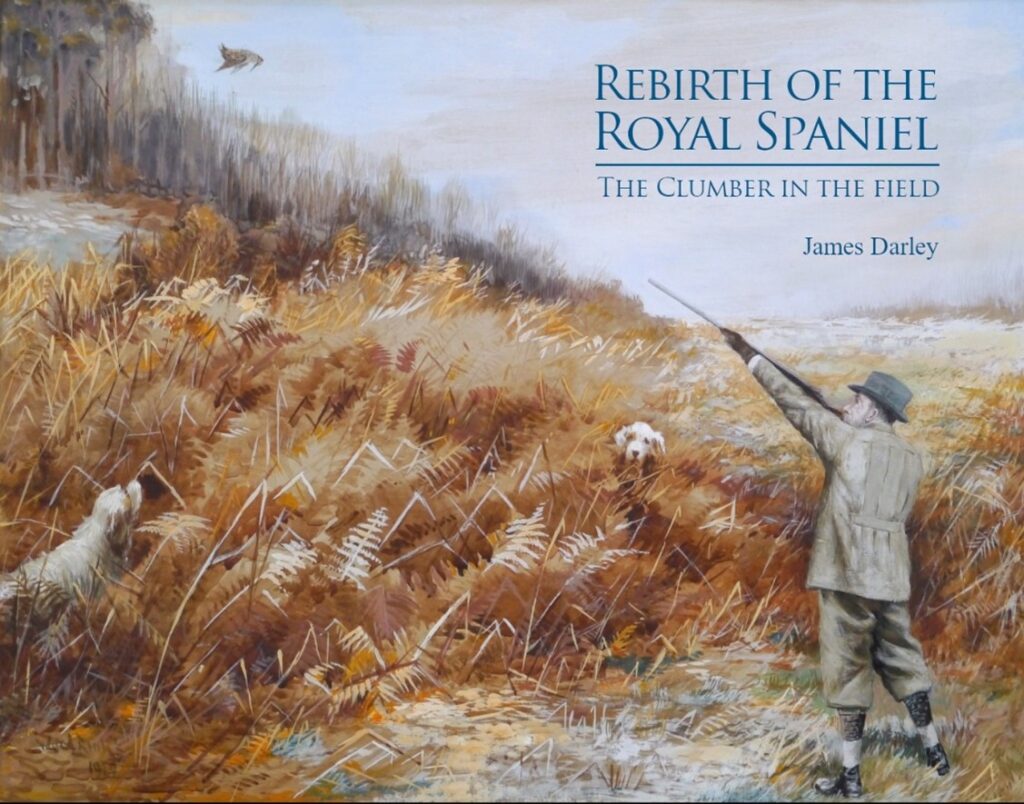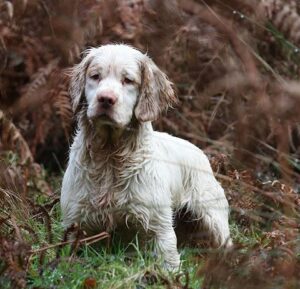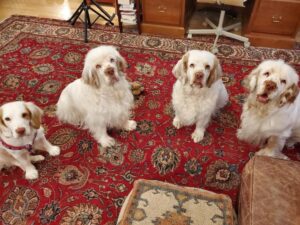
George V Shooting Woodcock, R. Ward Binks, 1929 from the
Queen’s private collection in Sandringham.
Questions are the engines of human intellect, and any historical inquiry necessarily begins with at least one in mind. Rebirth of the Royal Spaniel; The Clumber in the Field by James Darley is a historian’s quest to examine the record and determine what the Clumber spaniel historically was in stature and purpose. Mr. Darley mounts an impressive inquiry into the historical record sharing original documents, paintings and sources that have not previously been revealed anywhere else. Among the discoveries in the book is the debunking of the familiar story that Clumbers were imported to the UK from France at the time of the French Revolution. The author proves that they were in the UK long before then. The book is introduced by a letter from HRH Princess Anne who writes, “There is no one better than the author to share his experience and dedication in what in these pages is a celebration of the return of the Clumber spaniel.”
Rebirth of the Royal Spaniel is an important work because it is undertaken without regard for the ground beneath the writer falling away. There is no cherry-picking of selective sources, but an examination of the historical record in its entirety beginning before the French Revolution. This represents a lot of history as the Clumber spaniel is a 250-year-old British breed with a history that is steeped in Britain’s aristocracy and in its Royal kennels. Ownership of a Clumber spaniel was itself, until relatively recently restricted to England’s Royalty and aristocracy. The author, James Darley, started the UK Working Clumber Society (WCSS) in 1984 and gave Princess Anne, the President of the WCSS, a Clumber puppy in 1990. James Darley is singularly responsible for the rebirth of the UK Clumber spaniel as a prized working dog.
When I was asked by the author to write this review, being the daughter of a professor (a historian), my stance was one of skepticism. I was raised to be critical of historians. Historians after all are notoriously susceptible to many fallacies in their inquiry. This fragility begins when they start- in how they frame their initial questions. For example, some inquiries and histories are simple-minded, anachronistic, shallow, imprecise, or they create false dichotomies between things or terms which are neither mutually exclusive nor collectively exhaustive. Selectively using only those facts, which fit a pre-conceived narrative, can incorporate all of the foregoing fallacies, and contribute little to solving a puzzle or credibly adding to a body of knowledge.
Here is where James Darley’s work emerges above other historical works. While no serious historical inquiry can hope to know the totality of the events that happened, Rebirth of the Royal Spaniel tries harder than anything prior to get to an answer. It is the effort to strive to find the actual truth and examine the record as completely as possible that makes some historical inquiries far more valuable than others. James Darley’s research is exhaustive and thorough. His inquiry does not suffer the aforementioned historians’ fallacies. There is no pseudo proof or selective selection of sources. His examination of the record and conclusions as such create a work of historical importance to the Clumber spaniel breed. Without giving it all away, his case is decisively adjudicated in favor of the question he implicitly asks.
The Royal Spaniel narrates James Darley’s efforts to bring the Clumber spaniel breed back to its noble heritage and purpose. The telling of a story from an autobiographical perspective prescriptively warrants another dose of skepticism. Despite the dictum, “An unexamined life is not worth living,” what one of us can examine our own lives without some measure of self-deception? Here the writer’s credibility increases as the tale is unwoven, punctuated with humor. James Darley narrates episodes of his life that brought him to start the Working Clumber Spaniel Society (“WCSS”) 40 years ago. The reader is left with an appreciation of the enormity of the task he undertook.
Mr. Darley’s determination in single-handedly taking on the official kennel club of the United Kingdom, the Kennel Club (“KC”), which is the oldest recognized kennel club in the world along with most of the breeding establishment in the UK and the US, cannot be explained in any other way than a posture of looking outwards and beyond one’s own financial and reputation interests. “Nothing is more seductive for man than his freedom of conscience, but nothing is a greater source of suffering” (F. Dostoyevski, “the Grand Inquisitor” in The Brothers Karamazov).
By contrast, the line of least resistance in dog breeding is often to try and get along with other breeders, be political among them, and above all, breed to what is winning in the show ring at the time. This tendency to follow the leader is human nature whether observed in the behavior of masses in tulip manias and other financial bubbles, or in smaller sub-cultural groups like dog conformation clubs, and at an individual level. This is apparent in how easily dog breeders can create genetic bottlenecks and breed to the most conformationally winning popular sires, regardless of what may happen 30-40 years down the road in terms of population genetics. The payoff of having a winning show dog is short and medium term reputational along with possible financial gain. The payoff from thinking three to four decades ahead is by comparison a weak reinforcer. The negative effect of not breeding according to what is winning in the show ring at the time can be isolation or ostracization -strong and immediate social and financial costs. This somewhat explains why there are so many dog breeds that have been damaged by roving standards of conformation that have made certain dog breeds unfit for their original purpose, unable to breathe, or even exaggerated beyond recognition or health, at the hands of a few or even one charismatic breeder. In their tendency to follow a leader, dog breeders, even with good intentions towards breed health, can exhibit unmistakably herd-like behavior. It is in this environment that a very small group of people can have a disproportionately large and destructive impact on a very small breed.
Relative to other dog breeds, the Clumber spaniel breed is profoundly indebted to James Darley who objected to what he observed in the Clumbers 40 years ago. Since this time, the breed has again increased in sheer mass by almost 40 percent among certain conformation dogs. Some breeders speciously declare that this is attributable to better quality food as if humans and other species also increase by this percentage just by eating the equivalent of better kibble. To this James Darley questions what the purpose is of even having a conformation standard? Not an entirely unreasonable question given how often the breed club changes the standard over time as it has done so in American Clumbers.
For American Clumbers, the ideal standard in conformation in less than twenty years has gone from wanting dogs with “substantial” bone to the requirement that dogs have “massive” bone. To what logical end or for what purpose is somewhat murky and there is no upper parameter established to the definition of “massive.” What is interesting is that these standards are often changed and championed by those who have never even seen a Clumber do what it was originally bred to do.
There is a case for standards that Mr. Darley does not take into account and that is the need to have some ongoing morphological identification for a breed. He does counter by pointing to the absence of a KC or its misnamed breed standard during the breed’s formative first century and a half, when the dogs were no less distinctive or consistent in type while bred solely for what they could do. If there is no standard whatsoever going forward though, how is the breed to be identified as a distinct breed-what distinguishing characteristics will it have? Perhaps between a roving standard untethered to any meaningful function or purpose, and no morphological standard whatsoever, there is some middle ground.
In the retelling of how the Royal Clumber spaniel was restored, Darley is like many Brits, self-deprecating and understated in a way that is uniquely British and not at all American. What comes through is one man’s determination of will to restore the Clumber spaniel breed to its original purpose and form and how he did it.
Did he succeed? The reader can judge for themselves. Darley recounts many Clumber spaniels he raised to become field trial award winners over 40 years- a record unmatched by anyone else in the breed. In this time span there has been a resurgence in the number and spirit of this uniquely British dog towards a preeminence in field trials enjoyed by the breed 100 years ago.
Perhaps the decisive proof is in Huddlestone Midori Diamond, “Rigg,” owned by Jane and John Smith-Bodden. Rigg is the first Clumber spaniel in 100 years to win an All-Variety field trial against springer spaniels and cocker spaniels. Rigg drew international attention to the Clumber spaniel in the sporting press and is inarguable proof of the success of the WCSS.

By this measure, James Darley is the penultimate preservation breeder. As if by sleight of hand, this title has also been adopted by breeders who proclaim that unlike the UK working Clumbers, they have never split the breed. But the facts behind this assertion are not entirely robust. In the 50 years since its inception, the official breed club of the American Clumber spaniel has only had 13 master hunters…about two and half per decade. This is against the thousands of Clumbers that have been bred in that same time period and the thousands that are living in the United States.
Clumber spaniels are a sporting dog-a classification that denotes some measure of physical activity unlike for example, a toy breed. What is considered fit for their purpose in America is substantially different than what is considered fit for purpose in the UK. For example, American hunt tests are highly orchestrated and choreographed affairs unlike UK field trials. Unlike UK field trials, pen raised game birds are used and the first time they typically ever fly is when they are flushed at a hunt test. There is an inescapable cruelty to this as the birds are raised solely to be used and killed in spaniel training and spaniel hunt tests. Moreover, American hunt tests have birds planted in sight and there are clearly marked beginnings and ends to the course. UK field trials, unlike American spaniel field trials and hunts, have wild-living birds and they are found where they lie not systematically planted around the same locations for all dogs. The UK terrain also includes boundary walls and fences that Clumbers have to be able to jump over and cross. The average time for the land portion of a junior or senior hunter test is less than 10 minutes. And while there have been many junior and senior hunters, some of these dogs took many years and repeated attempts at tests to achieve these titles. Some junior and senior hunters become so by taking the same test dozens and dozens of times before passing. But if the pass rate is sufficiently low, the achievement of a title is arguably less of an accomplishment than an indictment of a breeding program or standard. So, the statement of many Americans that despite breeding decisively larger dogs they have not split the breed may well be aspirational or even counterfactual.
The Royal Spaniel is an engrossing read for anyone interested in the history of the Clumber spaniel or well researched history. It is also an important read. It would be interesting for anyone wanting an eye-witness account of a battle royale between conformation and performance in a dog breed. Dogs have been bred selectively for thousands of years to work in protection, detection, herding, hunting and hauling. Cultural anthropologists believe we may never have evolved into agrarian societies had it not been for our companions, our dogs. And the joy of seeing a dog’s DNA “speak,” when it is doing the task it was bred to do, never gets old. It is my hope that all breeders and Clumber owners read this work. In business as in life, there is benefit in understanding the Other. Competition, or even ideological differences can be a powerful catalyst for improvement-much more so than echo chambers. For the benefit of all Clumbers and those not yet even born, James Darley’s book is a substantial contribution to the Clumber spaniel breed within Britain’s sporting history written by the man who determined its course. It emerges as the definitive account of the Royal British breed, the Clumber spaniel.
*By way of some bona fides about myself-I have three American Clumbers, littermates, who acquired as adults earned just over 100 performance titles between them and many breed firsts in many venues, including the AKC hunt tests like the first AKC senior hunter advanced male and the first AKC senior hunter advanced female. 100 performance titles is a record in the Clumber spaniel breed. All three American Clumbers have done field work, two to the master hunter level, one is the breed’s 12th master hunter with 5/5 passes in a row and only one career non-pass. This one is also the breed’s first AKC Scent Work Master, among many many other breed firsts. His late brother was the first Clumber to get a master title in AKC scent work. Another breed first is the female who is the breed’s first AKC therapy dog excellent title holder-making 200 certified visits to hospitals and nursing homes. I also have a three year old UK working Clumber spaniel, who I started training for the field and is now being training to run in master hunter later this year.
